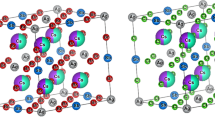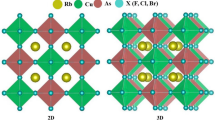Abstract
The sodium dihydrogen phosphate NaH2PO4 can be obtained by slow evaporation at room temperature and characterized by X-ray powder diffraction, scanning electron microscopy (SEM), and electrical impedance spectroscopy. The X-ray diffraction pattern revealed that the sample presents a single phase that crystallizes in the monoclinic structure with a P21/c space group, and the unit cell parameters are a = 6.8034 Å, b = 13.4014 Å, c = 7.2986 Å, and β = 92.827°. The dielectric impedance properties were studied over the range of frequency between 103 Hz and 1 MHz and in the temperature range of 300–440 K. The Z′ and Z″ versus frequency plots are well fitted to an equivalent circuit model. The circuits consist of the parallel combination of resistance (R), fractal capacitance (CPE), and capacitance (C). Furthermore, the frequency-dependent AC conductivity obeys Jonscher’s universal power law. In fact, the near values of activation energy obtained from the modulus spectra and conductivity confirm that the transport happens through a proton-hopping mechanism, dominated by the motion of the proton H+ in the structure of the investigated materials.












Similar content being viewed by others
References
Haile SM, Boysen DA, Chisholm CRI, Merle RB (2001) Solid acids as fuel cell electrolytes. Nature 410:910–913
Haile SM, Chisholm CRI, Sasaki K, Boysen DA, Uda T (2007) Solid acid proton conductors: from laboratory curiosities to fuel cell electrolytes. Faraday Discuss 134:17–39
Ginder RS, Pharr GM (2017) Creep behavior of the solid acid fuel cell material CsHSO 4. Scr Mater 139:119–121
Colomban P (1992) Proton conductors: solids, membranes and gels—materials and devices. Cambridge University Press, Cambridge
Goñi-Urtiaga A, Presvytes D, Scott K (2012) Solid acids as electrolyte materials for proton exchange membrane (PEM) electrolysis: Review. Int J Hydrog Energy 37:3358–3372
Castillo J, Materón EM, Castillo R, Vargas RA, Bueno PR, Varela JA (2008) Electrical relaxation in proton conductor composites based on (NH4)H2PO4/TiO2. Ionics 15:329–336
Cotton FA, Frenz BA, Hunter DL (1975) The structure of potassium hydrogen sulfate. Acta Crystallogr Sec B Struct Crystallogr Cryst Chem 31(1):302–330
Moskvich YN, Rozanov OV, Sukhovsky AA, Aleksandrova IP (2011) The study of phase transitions in crystals of ammonium hydrogen selenate family. Ferroelectrics 63(1):83–89
Rozanov OV, Moskvich YN, Sukhovskii AA (1983) The SE-77 High-Resolution NMR study of ferroelectric phase-transition in RBHSEO3. Fizika Tverdogo tela 25(2):376–380
Sukhovsky AA, Moskvich YN, Rozanov OV, Aleksandrova IP (2006) Polymorphism of the highly deuterated ammonium hydrogen selenate. Ferroelectr Lett Sect 3(2):45–52
Boysen DA (2004) High-performance solid acid fuel cells through humidity stabilization. Science 303:68–70
Soboleva LV, Voloshin AÉ (2002) Growth of single crystals of NaH2PO4 (NaDP), NaH2PO4 · H2O (NaDP · H2O), and NaH2PO4 · 2H2O (NaDP · 2H2O) sodium dihydrogenphosphate based on the analysis of the Na2O-P2O5-H2O phase diagram. Crystallography Reports 47:871–878
Zhang X, Liu C, Shen W, Ren Y, Li D, Yang H (2015) Solubility and physic-chemical properties of NaH2PO4 in phosphoric acid, sodium chloride and their mixture solutions at T=(298.15 and 313.15)K. J Chem Thermodyn 90:185–192
Catti M, Ferraris G (1974) Hydrogen bonding in the crystalline state. NaH2PO4, a crystal structure with a short symmetrical hydrogen bond. Acta Crysrallogr Sect B 30:1–6
Rietveld HM (1969) A profile refinement method for nuclear and magnetic structures. J Appl Crystallogr 2:65–71.
Rodriguez-Carvajal J (1993) Recent advances in magnetic structure determination by neutron powder diffraction. Physica B 192:55–69
Collins T (2011) Optical and Digital Image Processing. 859–877
Nasrin S, Manjura Hoque S, Chowdhury F-U-Z, Moazzam Hossen M (2014) IOSR. Influence of Zn substitution on the structural and magnetic properties of Co1-xZnxFe2O4 nano-ferrites. J Appl Phys 6:58–65
M'nassri R, Chniba Boudjada N, Cheikhrouhou A (2015) Impact of sintering temperature on the magnetic and magnetocaloric properties in Pr0.5Eu0.1Sr0.4MnO3 manganites. J Alloys Compd 626:20–28
Ungár T, Tichy G, Gubicza J, Hellmig RJ (2005) Correlation between subgrains and coherently scattering domains. Powder Diffract 20:366–375
Intatha U, Eitssayeam S, Wang J, Tunkasiri T (2010) Impedance study of giant dielectric permittivity in BaFe0.5Nb0.5O3 perovskite ceramic. J Curr Appl Phys 10:21–25
Abbassi M, Ternane R, Sobrados I, Madani A, Trabelsi-Ayadi M, Sanz J (2013) Ionic conductivity of apatite-type solid electrolyte ceramics Ca2−xBaxLa4Bi4(SiO4)6O2 (0≤x≤2). Ceram Int 39:9215–9221
Bechir MB, Karoui K, Tabellout M, Guidara K, Rhaiem AB (2014) Electric and dielectric studies of the [N(CH3)3H]2CuCl4 compound at low temperature. J Alloys Compd 588:551–557
Jonscher AK (1975) The Interpretation of Non-Ideal Dielectric Admittance and Impedance Diagrams. Phys State Sol (A) 32:665–667
Das BP, Choudhary RNP, Matapattra PK (2008) Impedance spectroscopy analysis of (Pb0.93 Gd 0.07)(Sn0.45Ti0.55)0.9825O3 ferroelectrics. Ind J Eng Mat Sci 15:152
Ram M (2010) A.c. conductivity and dielectric properties of LiNi3/5Cu2/5VO4 ceramics. Phys B 405:1359–1361
Lin YQ, Wu YJ, Chen XM, Gu SP, Tong J, Guan S (2009) Dielectric relaxation mechanisms of BiMn2O5 ceramics. J Appl Phys 105(5):05410
Chatterjee S, Mahapatra PK, Choudhary RNP, Thakur AK (2004). Complex impedance studies of sodium pyrotungstate– Na2W2O7. Phys Status Solid A 201:588–595
Chandra KP, Prasad K, Gupta RN (2007) Impedance spectroscopy study of an organic semiconductor: Alizarin. Phys B Condens Matter 388:118–123
Jonscher AK (1996) Universal relaxation law: a sequel to Dielectric relaxation in solids. Universal relaxation law. Chelsea Dielectric Press, London
Jonscher AK (1983) Dielectric relaxation in solids. Chelsea Dielectric Press, London
Elliott SR (1987) A.c. conduction in amorphous chalcogenide and pnictide semiconductors. Adv Phys 36:135–217
Howe AT, Shilton MG (1979) Studies of layered uranium (VI) compounds. I. High proton conductivity in polycrystalline hydrogen uranyl phosphate tetrahydrate. J Solid State Chem 28:345–361
Schechter A (2002) Imidazole and 1-methyl imidazole in phosphoric acid doped polybenzimidazole, electrolyte for fuel cells. Solid State Ionics 147:181–187
Diosa JE, Vargas RA, Albinsson I, Mellander B-E (2004) Dielectric relaxation of KH2PO4 above room temperature. Phys Status Solid B 241:1369–1375
Rhimi T, Leroy G, Duponchel B, Khirouni K, Guermazi S, Toumi M (2017). AC and DC conductivity study of LiH2PO4 compound using impedance spectroscopy. Ionics 1–8
T. Rhimi, M. Toumi, Kamel Khirouni, S. Guermazi, (2017) AC conductivity, electric modulus analysis of KLi(H2PO4)2 compound. Journal of Alloys and Compounds 714:546–552
Ye Y, Guo W, Wang L, Li Z, Song Z, Chen J, Zhang Z, Xiang S, Chen B (2017) Straightforward loading of imidazole molecules into metal–organic framework for high proton conduction. J Am Chem Soc 139:15604–15607
Ye Y, Zhang L, Peng Q, Wang G-E, Shen Y, Li Z, Wang L, Ma X, Chen Q-H, Zhang Z, Xiang S (2015) High Anhydrous Proton Conductivity of Imidazole-Loaded Mesoporous Polyimides over a Wide Range from Subzero to Moderate Temperature. J Am Chem Soc 137(2):913–918
Ye Y, Wu X, Yao Z, Wu L, Cai Z, Wang L, Ma X, Chen Q-H, Zhang Z, Xiang S (2016) Metal–organic frameworks with a large breathing effect to host hydroxyl compounds for high anhydrous proton conductivity over a wide temperature range from subzero to 125 °C. J Mater Chem A 4:4062–4070
Kumari K, Prasad A, Prasad K (2016) impedance/modulus and conductivity studies on [Bi 0.5(Na 1-x Kx) 0.5] 0.94 Ba 0.06 TiO 3, (0.16≤ x≤ 0.20) lead-free ceramics. J Mat Sci 6:1–18
Migahed MD, Bakr NA, Abdel-Hamid MI, El-Hanafy O, El Nimr M (1996) Dielectric relaxation and electric modulus behavior in poly(vinyl alcohol)-based composite systems. J Appl Polym Sci 59:655–662
Saha S, Sinha TP (2005) Low-temperature scaling behavior of BaFe0.5Nb0.5O3. Phys Rev B 65:13
Padmasree KP, Kanchan DD, Kulkami AR (2006) Impedance and modulus studies of the solid electrolyte system 20CdI2–80[xAg20–y(0.7V2O5–0.3B2O3)], where 1≤x/y≤3. Solid State Ionics 177:475–482
Elliott SR (1988) Frequency-dependent conductivity in ionic glasses: a possible model. Solid State Ionics 27:131–149
Barik SK, Choudhary RNP, Singh AK (2011) Ac impedance spectroscopy and conductivity studies of Ba0.8Sr0.2TiO3 ceramics. Adv Mat Lett 2:419–421
Bergman R (2000) General susceptibility functions for relaxations in disordered systems. J Appl Phys 88:1356–1365
Cao MS, Hou ZL, Yuan J, Xiong LT, Shi XL (2009) Low dielectric loss and non-Debye relaxation of gamma-Y2Si2O7 ceramic at elevated temperature in X-band. J Appl Phys 105:106102
Nasri S, Megdiche M, Gargouri M (2016) The investigation of dielectric properties and ac conductivity of new ceramic diphosphate Ag 0.6 Na 0.4 FeP 2O 7 using impedance spectroscopy method. Physica E: Low-dimensional Systems and Nanostructures 84:182–190
Author information
Authors and Affiliations
Corresponding author
Rights and permissions
About this article
Cite this article
Rhimi, T., Leroy, G., Duponchel, B. et al. Electrical conductivity and dielectric analysis of NaH2PO4 compound. Ionics 24, 3507–3514 (2018). https://doi.org/10.1007/s11581-018-2494-6
Received:
Revised:
Accepted:
Published:
Issue Date:
DOI: https://doi.org/10.1007/s11581-018-2494-6




